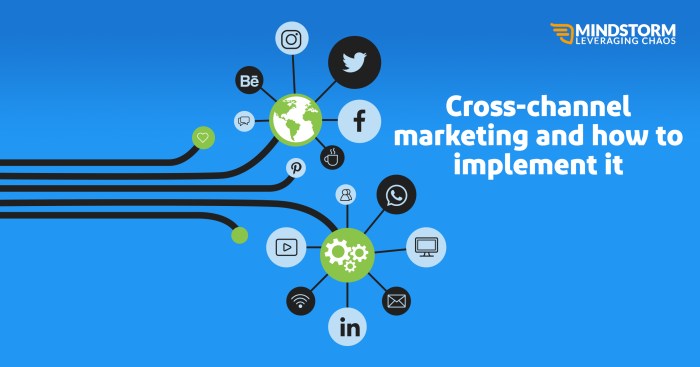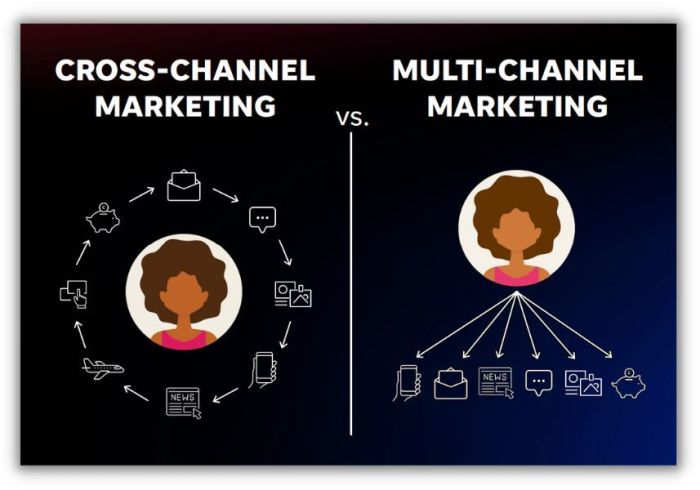Understanding Cross-Channel Marketing opens the door to a whole new level of marketing savvy. Get ready to dive into the world of integrated marketing strategies with a twist of modern flair.
From defining cross-channel marketing to exploring its benefits and strategies, this topic will take you on a journey through the dynamic landscape of digital marketing.
Definition of Cross-Channel Marketing

Cross-channel marketing is a strategy that involves reaching customers across multiple platforms and devices in a seamless and integrated way. It differs from other marketing strategies by focusing on creating a cohesive experience for consumers as they move between different channels.
Examples of Cross-Channel Marketing Campaigns
- Starbucks: Starbucks has successfully implemented cross-channel marketing by allowing customers to order and pay for their drinks through their mobile app, website, or in-store, creating a consistent experience across all channels.
- Nike: Nike’s “Just Do It” campaign is a prime example of cross-channel marketing, where they promote their products through TV ads, social media, and in-store promotions, ensuring that customers see a consistent message everywhere they go.
- Amazon: Amazon uses cross-channel marketing by leveraging data from customers’ browsing history to recommend products through email, on their website, and through push notifications on their mobile app, creating a personalized shopping experience.
Importance of Integrating Multiple Channels in a Marketing Strategy
Integrating multiple channels in a marketing strategy is crucial for reaching customers where they are and providing a seamless experience. By connecting channels such as social media, email, websites, and in-store promotions, brands can create a consistent message and build stronger relationships with their audience. This approach increases brand visibility, customer engagement, and ultimately leads to higher conversion rates and customer loyalty.
Benefits of Cross-Channel Marketing

Cross-channel marketing offers numerous advantages for businesses looking to enhance their marketing strategies and reach their target audience more effectively.
Improved Customer Engagement
Cross-channel marketing allows businesses to engage with customers on multiple platforms, providing a seamless and cohesive experience. By connecting with customers through various channels such as social media, email, and websites, businesses can build stronger relationships and increase brand loyalty.
- Creating personalized and targeted messages based on customer behavior and preferences.
- Enhancing customer experience by providing consistent messaging across all channels.
- Encouraging interaction and feedback from customers through various touchpoints.
Increased Conversions and ROI
Implementing a cross-channel marketing strategy can lead to higher conversion rates and improved return on investment for businesses. By reaching customers at different stages of the buying journey and guiding them through the sales funnel, businesses can drive more conversions and ultimately boost their bottom line.
- Optimizing marketing campaigns based on data and insights gathered from various channels.
- Tracking customer interactions and attributing conversions to specific touchpoints.
- Maximizing marketing spend by identifying the most effective channels for driving conversions.
Strategies for Implementing Cross-Channel Marketing: Understanding Cross-Channel Marketing
Implementing a successful cross-channel marketing plan requires careful planning and execution. By following a strategic approach, businesses can effectively reach their target audience across multiple platforms and drive better results.
Creating a Successful Cross-Channel Marketing Plan
To create a successful cross-channel marketing plan, businesses should follow these key steps:
- Define clear goals and objectives for each marketing channel.
- Identify the target audience and understand their preferences and behaviors.
- Create a consistent brand message and visual identity across all channels.
- Select the right mix of channels based on the target audience and marketing goals.
- Develop personalized content tailored to each channel and audience segment.
- Implement tracking and analytics to measure the performance of each channel.
- Continuously optimize the marketing plan based on data and insights.
Role of Data Analytics in Optimizing Cross-Channel Marketing Campaigns
Data analytics plays a crucial role in optimizing cross-channel marketing campaigns by providing valuable insights into customer behavior, channel performance, and campaign effectiveness. By analyzing data from different channels, businesses can:
- Identify high-performing channels and allocate resources effectively.
- Track customer interactions across channels to understand the customer journey.
- Segment the audience based on behavior and preferences for targeted marketing.
- Measure the ROI of each channel and campaign to optimize marketing spend.
Ensuring Consistency Across Different Marketing Channels, Understanding Cross-Channel Marketing
To ensure consistency across different marketing channels, businesses should follow these tips:
- Use a centralized brand style guide to maintain consistent messaging and visual identity.
- Coordinate marketing efforts across channels to provide a seamless customer experience.
- Regularly review and update content to ensure relevance and consistency.
- Monitor customer feedback and adjust strategies to address any inconsistencies or gaps.
Challenges and Solutions in Cross-Channel Marketing
Implementing cross-channel marketing can come with its fair share of challenges, but with the right strategies in place, these obstacles can be overcome to achieve successful integration and measurement of marketing efforts.
Common Challenges Faced
- Disconnected Customer Experience: Customers may experience inconsistencies when interacting with a brand across different channels, leading to confusion and frustration.
- Data Silos: Data collected from various channels may be stored separately, making it difficult to have a unified view of customer behavior and preferences.
- Resource Constraints: Managing multiple channels simultaneously can be resource-intensive, requiring a dedicated team and budget.
- Channel Proliferation: The constant emergence of new marketing channels can make it challenging to keep up and maintain a cohesive strategy.
Solutions to Overcome Integration Issues
- Implement a Customer Data Platform (CDP): A CDP can help consolidate customer data from different channels into a single source of truth for better personalization and targeting.
- Streamline Communication: Ensure seamless communication and alignment between teams managing different channels to maintain consistency in messaging and branding.
- Invest in Technology: Utilize marketing automation tools and analytics platforms to streamline processes and gain insights for optimizing cross-channel campaigns.
- Adopt an Omnichannel Approach: Focus on creating a seamless customer experience across all touchpoints by integrating channels for a unified brand experience.
Measuring Success in Cross-Channel Marketing
- Define Key Performance Indicators (KPIs): Establish specific metrics to track the performance of each channel and overall campaign effectiveness.
- Attribution Modeling: Use advanced attribution models to accurately attribute conversions and ROI to the various touchpoints along the customer journey.
- A/B Testing: Conduct experiments to optimize messaging and channel mix, allowing for data-driven decisions based on performance results.
- Customer Feedback and Surveys: Collect feedback from customers to understand their preferences and satisfaction levels with the cross-channel experience.
